#Wimbledon title defense
Explore tagged Tumblr posts
Text
#Carlos Alcaraz#Coco Gauff#Jannik Sinner#Wimbledon 2024#opening day#tennis#Grand Slam#Mark Lajal#Yannick Hanfmann#Emma Raducanu#Ekaterina Alexandrova#Aryna Sabalenka#Emina Bektas#Daniil Medvedev#Casper Ruud#Caroline Dolehide#Centre Court#Court One#All England Club#Wimbledon title defense#grass court#tennis news#Wimbledon schedule#Vivek Mishra
0 notes
Text
unpopular opinion but I don’t want a sincaraz uso final and I have my reasons! because here’s how the sequence of sincaraz slam matches have been:
r16 at wimbledon
qf at uso
sf at rg
therefore their next grand slam match should be the ao final. and think about the narratives: jannik going for his first slam title defense, carlos going for a career grand slam. and the winner of this match? well it depends on how many more matches they play this year because the h2h is still following the tiebreak pattern and I hope it does forever
#(also in this dream scenario for next year daniil wins rg I haven’t forgotten about him)#jannik sinner#carlos alcaraz#sincaraz
39 notes
·
View notes
Note
another backstory ask: what do you think art’s tennis career is like? when do you think he won his grand slams, what order he did them, what was his highest ranking, etc.?
Ooh I have lots of thoughts. I deliberately don't have a set chart of everything + I don't work too hard to be consistent from fic to fic because I want to have some flexibility for what works in the moment. For instance, Art saying he last played doubles with Serena at the 2016 Olympics is something that's useful in that moment, and totally plausible + a fun idea, but it's there to serve the dynamic in the scene.
Likewise I don't have all his Slams pinned to the timeline (the French Opens frankly I have no idea though they come later by default).
My basic narrative though is that he's already quite successful (Top 25ish) by the time the Tashi connection happens in 2010, which means he's getting hyped as the great American hope by people who Need That to Happen. But also this means there's a backlash from know-it-alls that He Just Doesn't Have It (the know-it-alls at this point are CORRECT, they're just annoying). I already spent too much time on the back half of that season in 'Waltz for Tashi,' but from there they go to Australia in Jan 2011 + win an AO that's something of a fluke (top seeds dropping etc) but is impressive in its own way and US sports media simultaneously falls in love with the Donaldsons and starts a cycle of whether Art is For Real and Can she possibly REALLY be his coach?? Also this shoots him up the rankings and he's basically ensconced in Top 5 for the next several years.
First Wimbledon: 2012, he gushes about Tashi in his oncourt speech + they are Mainstream American Sports stars/on their way to legit Celebrities from this point on. 2013 is the Donaldsons' Annus Mirabilis; Art wins AO in convincing fashion, makes #1 they have victory sex that gets Tashi pregnant [complicated complicated in the end they're keeping that baby ], wins Wimbledon, makes a USO final (Rafa again, instant classic, even Tashi says there wasn't anything he could have done better). Post-USO Art goes to China without very pregnant Tashi, does not WANT to go but has a title defense in Shanghai that he needs to secure year end #1, which he does, jokes in his speech about how he wanted to lose early to *make sure he doesn't miss the birth of his child* but Tashi told him if he lost he wasn't allowed to come home which gets a laugh but is KIND OF true, she scheduled sponsor events so he wouldn't be able to bail if he lost. This didn't make it into 'Qualifying' but my concept was that was when she started making those videos for his matches. Pregnant and stuck at home and furious about it, a girl is saved by video editing software.
That's as far as I go, 2014-2019 is vague to me because I haven't needed it for a story. Art becomes an unlikely clay court specialist in there somewhere...??
More backstory asks welcome in the inbox!
4 notes
·
View notes
Text
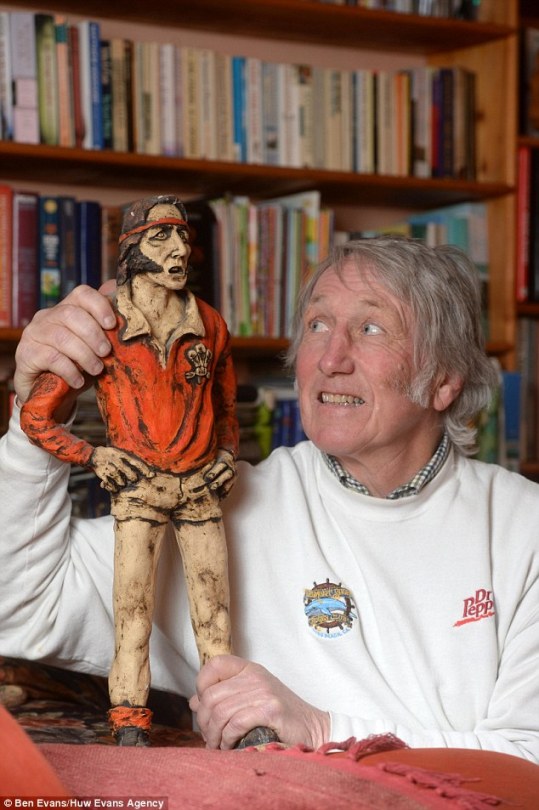
In the closing minutes of Wales’s Five Nations meeting with France at Cardiff Arms Park in March 1976, the home side were resisting an onslaught by the visitors when the French wing Jean-François Gourdon found some space on the touchline by the north stand. Gourdon was then hit by a shuddering shoulder charge from Wales’s full-back, JPR Williams, that all but sent him spinning into the crowd. Williams raised his fist in triumph and Wales held on to win 19-13 and complete a seventh grand slam.
In truth, Williams’s tackle was far from legal, but the incident remains an indelible image in the minds of Welsh rugby supporters – that and a photograph of the Bridgend No 15 with blood pouring from his face after being trampled by a visiting All Blacks boot. International rugby in the 1970s was not for the squeamish, and JPR survived by being not just supremely skilful, but as hard as nails.
Williams, who has died aged 74 from bacterial meningitis, would forever be known as JPR, the three most evocative initials in the sport. Only France’s Serge Blanco could rival him as the greatest full-back in history. When the law-makers of the international board prevented the ball from being kicked directly into touch in 1968 it gave the opportunity for Williams and others such as Scotland’s Andy Irvine to forge a template for how a modern attacking full-back should play.
The source of Williams’s famous hardness is surprising. Unusually for top-class players in Wales, he came from a comfortable middle-class home. Williams once told of how he turned up at a Wales Schoolboys’ trial in a Rolls Royce. His upbringing, he said served as an incentive “to prove to my mates that I was tough and one of them”.
John Peter Rhys was born in Bridgend to Peter and Margaret, both doctors. Margaret had been born in Rochdale, so young John could have played for England, but that was not a subject much discussed in the Williams household.
It was on the lawns of Wimbledon rather than the muddy fields of Cardiff Arms Park or Bridgend that Williams first made his mark as a sportsman of renown. As a 17-year-old, he won the 1966 British junior tennis title at Wimbledon, beating David Lloyd in the final.
He was gaining a reputation at rugby in Bridgend, where his father was the club president and doctor. By this time Williams had left Bridgend grammar school for Millfield school in Somerset, where future Wales scrum-half Gareth Edwards was a pupil.
From Millfield, Williams went to St Mary’s hospital in London and had a spell at the London Welsh club. He chose to continue playing the amateur sport rather than tennis and concentrate on his medical studies, his father having told him that he would not make a living as a professional sportsman.
He was still a teenager when he was called into a Wales squad to tour Argentina in the summer of 1968. There were great expectations of the new boy John Williams, as he was then known, when he made his full Wales debut against Scotland at Murray Field the following February.
Wales had a new coach, their former captain Clive Rowlands. Barry John at fly-half scored the final try in Wales’s 17-3 win. Something was brewing in Wales and the 70s were a golden age. Once Phil Bennett, alongside Edwards, established himself as Barry John’s natural heir and once JPR was joined by the wings JJ Williams and Gerald Davies, Wales became an unstoppable force in northern hemisphere rugby. At the heart of their team was JPR, instantly recognisable with his Elvis-Presley style sideburns, flowing hair and socks often pulled down to his ankles.
What set him apart was his success as an attacking player which, allied to that rock-solid defensive play, made him a permanent fixture in the Wales side between his 1969 debut and 1981, when he retired from international rugby. He burnished his reputation on the successful British Lions tours to New Zealand in 1971 and South Africa in 1974, playing in all four Tests on each. Williams had been on a Wales tour to New Zealand in 1969 when they were humbled by the All Blacks in two Tests so the 2-1 series win by the Lions two years later came as a big relief.
In Auckland he settled the series with a long-range drop-goal in the final Test. It came as a surprise to his team-mates, but England’s Bob Hiller, his full-back understudy on that tour, had apparently joked to him that he could not consider himself a proper international until he had dropped a goal.
In South Africa three years later, Williams was heroic again as Willie John McBride’s team prevailed in an often brutal series win over the Springboks. The Lions’ call of “99” often signalled all-out punch-ups, and the sight of Williams racing upfield to thump the much larger South African lock Moaner van Heerden was a memorable one, though, as Williams confessed later it was not something of which he was particularly proud.
Williams won 55 caps for Wales, five of them as captain in 1978-79; in 1977 he was appointed MBE. In between those Lions victories he scored the final try in the Barbarians’ famous victory over the All Blacks at the Arms Park in 1973, and after retiring from the international stage played club rugby for Tondu as a back-rower until 2003, when he was 54.
He met Scilla (Priscilla) Parkin at medical school, and they married in 1973. His principal post as a trauma and orthopaedic surgeon was at the Princess of Wales hospital, Bridgend (1986–2004). Williams rarely joined the ranks of retired players who became pundits, but he was always happy to talk about a stellar career, particularly the 11 games against England, in which he always ended on the winning side.
He is survived by Scilla and their children, Lauren, Annie, Fran and Peter.
🔔 John Peter Rhys Williams, rugby player and orthopaedic surgeon, born 2 March 1949; died 8 January 2024
Daily inspiration. Discover more photos at Just for Books…?
9 notes
·
View notes
Text

First Lieutenant Arthur Robert Ashe Jr. (July 10, 1943 – February 6, 1993) was a tennis player who won three Grand Slam singles titles.
He was born in Richmond, Virginia to Arthur Ashe Sr. and Mattie Cordell Cunningham Ashe. He had a brother, who was five years younger than him.
He became the first African American to win the National Junior Indoor tennis title and was awarded a tennis scholarship to UCLA.
After graduating with a BA in Business Administration from UCLA, he joined the United States Army. He completed his basic training in Washington and was commissioned as a second lieutenant in the Adjutant General Corps. He was assigned to the United States Military Academy at West Point where he worked as a data processor. He headed the academy’s tennis program. He was discharged from the Army as a 1st Lieutenant. He was awarded the National Defense Service Medal for his service. He served 2 years.
He was the first African American player selected to the US Davis Cup team and the only African American man ever to win the singles title at Wimbledon, the US Open, and the Australian Open. He retired in 1980. He was ranked world #1 by Harry Hopman in 1968 and by Lance Tingay of The Daily Telegraph and World Tennis Magazine in 1975. In the ATP computer rankings, he peaked at #2 in May 1976.
He is believed to have contracted HIV from a blood transfusion he received during heart bypass surgery. He publicly announced his illness in April 1992 and began working to educate others about HIV and AIDS. He founded the Arthur Ashe Foundation for the Defeat of AIDS and the Arthur Ashe Institute for Urban Health before his death from AIDS-related pneumonia.
He married photographer and graphic artist Jeanne Moutoussamy (1977). They adopted a daughter.
He was posthumously awarded the Presidential Medal of Freedom by President Bill Clinton. #africanhistory365 #africanexcellence #kappaalphapsi
2 notes
·
View notes
Text
Who is the Best Tennis Player of All Time?

Tennis, a game so renowned for its elegance, athleticism, and ferocity of competition, has created many legends across the decades. But when the ultimate question pops up—who is the greatest tennis player of all time?—The answer is anything but straightforward. The debate crosses generations, surfaces, playing styles, and individual tastes. But some names always figure in this debate: Roger Federer, Rafael Nadal, Novak Djokovic, Serena Williams, and Steffi Graf.
Here, we’ll examine the qualifications that go into creating the “best,” analyze the careers of strong contenders, and weigh who deserves the title of Best Tennis Player in history.
Defining “Best” in Tennis
Before we crown anyone as the best, it’s crucial to establish what “best” actually means in tennis. Here are some of the key metrics and factors used to evaluate greatness:
Grand Slam Titles: The most prestigious tournaments in tennis—the Australian Open, French Open, Wimbledon, and US Open—are considered the highest benchmark.
Career Longevity: Sustained success over many years shows consistency and adaptability.
Head-to-Head Records: Dominance over other top players in direct matches.
Surface Versatility: Excellence across grass, clay, and hard courts.
Records and Milestones: Holding world records, achieving calendar Grand Slams, or historic winning streaks.
Influence on the Game: Impact on popularizing the sport and inspiring future generations.
Now, let’s explore the elite group of athletes who are most often considered for the title of Best Tennis Player.
Top 5 Best Tennis Players: Legends Who Dominate the Court?
1. Roger Federer – The Maestro of Elegance
Roger Federer is often the first name that comes to mind. With 20 Grand Slam titles and a career that spanned over two decades, Federer captivated the tennis world with his graceful play, pinpoint accuracy, and impeccable sportsmanship.
Strengths: Federer’s one-handed backhand, fluid movement, and versatility made him a fan favorite.
Longevity: Turned pro in 1998 and remained competitive well into his late 30s.
Records: Held the World No. 1 ranking for a record 310 weeks, including 237 consecutive weeks.
zhough his Grand Slam tally has been surpassed, Federer’s legacy is etched in the hearts of tennis fans worldwide. His charisma and on-court artistry make a compelling case for his place among the best.
2. Rafael Nadal – The King of Clay
Rafael Nadal is synonymous with dominance, particularly on clay courts. With 22 Grand Slam titles, including a record 14 French Open wins, Nadal’s intensity and athleticism are unmatched.
Strengths: Relentless topspin, stamina, and mental toughness.
Surface Dominance: Nadal’s performance on clay is arguably the greatest any player has shown on a single surface.
Fighting Spirit: Known for his comebacks and never-say-die attitude.
Nadal’s career has been plagued by injuries, yet he has consistently bounced back to reclaim titles and defy expectations. His dominance on clay and versatility elsewhere strengthen his argument as the Best Tennis Player in history.
3. Novak Djokovic – The Statistical Giant
Novak Djokovic, currently holding the record for the most Grand Slam singles titles among men (24 as of 2024), has transformed the landscape of modern tennis. His extraordinary consistency, adaptability, and mental strength have redefined excellence.
Strengths: Exceptional return of serve, defensive skills, and flexibility.
Complete Game: Excelled across all surfaces with multiple wins on each.
Records: Over 400 weeks at World No. 1, the most in ATP history.
What makes Djokovic especially compelling is his ability to dominate during an era shared with Federer and Nadal. His head-to-head record against both legends is positive, giving him a statistically sound case to be labeled the Best Tennis Player ever.
Read Also: Rage, Respect & Records: The Biggest Rivalry in Sports Unpacked
4. Serena Williams – The Queen of the Court
No discussion of tennis greatness is complete without Serena Williams. With 23 Grand Slam singles titles—the most in the Open Era—Serena’s power, precision, and dominance revolutionized women’s tennis.
Strengths: Powerful serve, aggressive baseline play, and competitive drive.
Longevity: Spanning over two decades at the top of the game.
Legacy: Broke barriers in sport, fashion, and culture.
Serena’s influence goes far beyond the court. She changed how women’s tennis is viewed and inspired a new generation of athletes. Many consider her the best tennis player not just among women, but in the sport’s history.
5. Steffi Graf – The Golden Slam Legend
Steffi Graf boasts one of the most extraordinary achievements in tennis: the Golden Slam—winning all four Grand Slams and an Olympic gold medal in a single year (1988).
Strengths: Blazing forehand, incredible footwork, and mental toughness.
Achievements: 22 Grand Slam titles and 377 weeks as World No. 1, a record in both men’s and women’s tennis.
Adaptability: Dominated across all surfaces with unparalleled grace.
Graf’s dominance during the 1980s and 1990s, particularly in an era with fewer advancements in sports science and training, adds weight to her claim as the Best Tennis Player.
Comparing the Greats
Here’s a quick comparison of key metrics:
Player
Grand Slams
Weeks at No. 1
Surface Versatility
Olympic Gold
Roger Federer
20
310
Yes
Doubles
Rafael Nadal
22
209
Yes
Singles
Novak Djokovic
24
400+
Yes
Singles
Serena Williams
23
319
Yes
Singles
Steffi Graf
22
377
Yes
Singles
While Grand Slam totals are a major indicator, it’s clear that greatness encompasses much more—sustained excellence, global impact, and dominance across conditions.
The X-Factor: Influence and Legacy
Another layer to the debate is the influence each player had on the sport and society. Federer brought global elegance and mainstream popularity. Nadal inspired with his resilience. Djokovic showcased the power of discipline and belief. Serena broke racial and gender barriers, while Graf was a trailblazer in global women’s tennis.
The Best Tennis Player may not only be the one with the most trophies but the one who left the deepest imprint on the game.
So, Who Is the Best Tennis Player?
Choosing the best is inherently subjective and often influenced by personal biases, national pride, or the era in which one grew up watching tennis. Statistically, Novak Djokovic currently holds the edge in major titles and weeks at No. 1. Emotionally, Roger Federer’s artistry and sportsmanship have endeared him to fans. Spiritually, Rafael Nadal’s grit resonates deeply. And for many, Serena Williams’ and Steffi Graf’s trailblazing legacies are beyond compare.
In the end, perhaps the best answer is this: the title of Best Tennis Player may belong to more than one. Each legend shaped the sport in unique ways and raised the bar for future generations.
Read Also: Legends of the Court: Ranking the Best Basketball Players of All Time
Conclusion
Tennis goes on to develop, with new heroes emerging on the landscape. But the records of Federer, Nadal, Djokovic, Serena, and Graf cannot be equalled—each one worthy of the Best Tennis Player title individually. The GOAT argument may never end, but it is this same debate that keeps the game alive, thrilling, and full of passion.
No matter whether you admire numbers, aesthetics, or their social contribution, one thing is sure: we are experiencing a golden age of tennis that owes its existence to icons whose legacy will be felt across generations.
0 notes
Text
Alex de Minaur: Australia’s Rising Star on the Wimbledon Grass

Alex de Minaur, a talented Australian tennis player, has become a prominent figure on the grass courts of Wimbledon, displaying remarkable skill and determination in his matches. Born on February 17, 1999 in Sydney, Australia, de Minaur has quickly risen through the ranks of professional tennis, earning praise for his speed, agility and versatile playing style. Beginning of career and rise to prominence De Minaur’s tennis journey began at a young age, demonstrating a natural aptitude for the sport. He quickly gained attention on the youth circuit, winning numerous titles and displaying a tenacity that would define his future career. His breakthrough came in 2016, when he won the Australian Open men’s singles title, setting the stage for his transition to the professional circuit.
Professional success and playing style As a professional, De Minaur earned a reputation for his relentless baseline play and exceptional defensive skills. Standing 6 feet tall, he combines speed and accuracy, making him a formidable opponent on fast surfaces such as grass. His ability to recover seemingly impossible shots and turn defense into offense has earned him the admiration of fans and teammates. Shows at Wimbledon Wimbledon, known for its lush grass courts and prestigious history, was a platform for De Minaur to showcase his talent. His speed and agility make him ideal for the fast and unpredictable nature of lawn tennis. Throughout his career, De Minaur has competed ferociously at Wimbledon, aiming to make his mark at one of the sport’s most iconic tournaments.
Highlights and professional results De Minaur’s career highlights include numerous ATP Tour titles and strong performances in Grand Slam tournaments. His determination and work ethic have propelled him to the highest levels of men’s tennis, where he continues to evolve as a player and role model for aspiring athletes.
Person and impact off the pitch Beyond his ability on the pitch, De Minaur is known for his affable personality and sporting spirit. He endeared himself to fans for his humility and dedication to continuously improve his game. Off the court, he is actively involved in his community and is committed to inspiring the next generation of Australian tennis stars. Future Prospects As he continues to mature as a player, Alex de Minaur remains a player to watch on the ATP Tour, particularly on the grass courts of Wimbledon. His ambition to compete at the highest level and constant commitment to excellence position him as a key figure in the future of Australian tennis. In conclusion, Alex de Minaur’s journey to prominence at Wimbledon and in the world of tennis reflects not only his abilities as an athlete, but also his resilience and passion for the sport. With every match, he reinforces his legacy as Australia’s rising star on the grass of Wimbledon.
1 note
·
View note
Text
Welcome to Grass Court season
Ranking the Greatest Grass Court Players of the Open Era
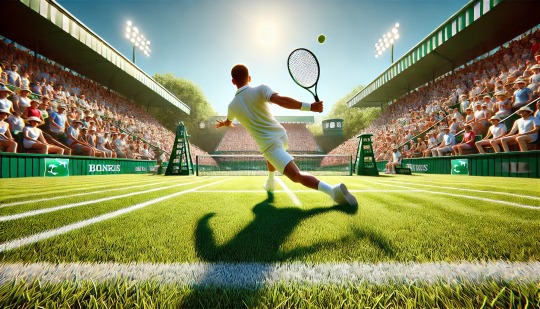
As the grass court season begins, tennis enthusiasts around the world turn their attention to the lush, green courts that have hosted some of the sport's most iconic moments. Grass courts, with their fast pace and low bounce, require a unique set of skills and strategies, making victories on this surface particularly noteworthy. Let's delve into what made some of the greatest grass court players of the Open Era so successful.
1. Roger Federer: The Maestro of Grass
Roger Federer stands at the pinnacle of grass court tennis. His record eight Wimbledon titles and unparalleled 105 match wins at the tournament underscore his dominance. Federer’s game is characterized by his fluid movement, precise footwork, and an almost poetic serve-and-volley technique. His ability to play aggressive yet controlled tennis, combined with a powerful serve and impeccable net play, allows him to dictate points and keep opponents on the defensive.
One of the most memorable moments in Federer’s illustrious career was the 2017 Wimbledon final, where he defeated Marin Čilić 6-3, 6-1, 6-4. This victory was significant not only because it marked his eighth title, but also because Federer became the oldest player in the Open Era to win Wimbledon without dropping a set throughout the tournament.
2. Pete Sampras: The Serve-and-Volley King
Pete Sampras ruled Wimbledon in the 1990s with his powerful serve and aggressive net play. His serve-and-volley style was perfectly suited for the fast-paced grass courts, allowing him to dominate points quickly and keep rallies short. With seven Wimbledon titles to his name, Sampras was the epitome of grass court excellence during his era.
A particularly standout performance was his 1999 Wimbledon final against Andre Agassi, where Sampras won convincingly 6-3, 6-4, 7-5. This match showcased his superior grass court prowess and solidified his reputation as one of the greatest ever to play on the surface.
3. Bjorn Borg: The Ice Man of Wimbledon
Bjorn Borg’s five consecutive Wimbledon titles from 1976 to 1980 are a testament to his mastery of grass courts. His game was a blend of relentless baseline play and exceptional footwork, allowing him to excel on grass despite it being less common for baseline players to dominate on this surface.
Borg’s iconic victory over John McEnroe in the 1980 Wimbledon final, where he won 1-6, 7-5, 6-3, 6-7(16-18), 8-6, remains one of the greatest matches in tennis history. This match exemplified his incredible resilience and mental toughness, qualities that made him a formidable opponent on grass.
4. Novak Djokovic: The Modern Master
Novak Djokovic’s seven Wimbledon titles highlight his adaptability and excellence on grass. Known for his extraordinary agility, defensive skills, and mental resilience, Djokovic has been able to translate his all-court game to grass with great success.
His triumph in the 2019 Wimbledon final against Roger Federer, winning 7-6(5), 1-6, 7-6(4), 4-6, 13-12(3), was the longest final in Wimbledon history and showcased his unparalleled endurance and mental toughness. This victory not only added another title to his collection but also solidified his legacy as one of the greatest grass court players of all time.
5. Rod Laver: The Versatile Champion
Rod Laver’s versatility and powerful groundstrokes, along with his strategic use of the entire court, made him a dominant force on grass. Laver’s adaptability and mastery of different surfaces, including grass, were key to his success.
Laver’s back-to-back calendar-year Grand Slams in 1962 and 1969, the latter achieved in the Open Era, included victories at Wimbledon, underscoring his dominance. His ability to seamlessly transition between different styles of play allowed him to outmaneuver opponents and control matches on grass.
6. John McEnroe: The Volatile Genius
John McEnroe’s serve-and-volley game, characterized by his exceptional touch and volleying skills, was ideally suited for the fast and low-bouncing grass. His ability to control points with his serve and quick reflexes at the net made him a formidable grass court player.
McEnroe’s dramatic victory over Bjorn Borg in the 1981 Wimbledon final, winning 4-6, 7-6(1), 7-6(4), 6-4, ended Borg’s five-year reign and marked McEnroe’s emergence as a grass court legend. His intense on-court demeanor and competitive spirit were hallmarks of his game, driving him to excel in high-stakes matches.
7. Boris Becker: The Young Wunderkind
Boris Becker’s aggressive style and athleticism made him particularly effective on grass, where his big serve and bold approaches to the net paid dividends. Becker’s ability to play with high intensity and his knack for performing well under pressure made him a tough opponent on grass.
His victory in the 1985 Wimbledon final at just 17 years old, where he defeated Kevin Curren 6-3, 6-7(4), 7-6(3), 6-4, made him the youngest ever male Wimbledon champion, a record that still stands. This win marked the beginning of an illustrious career and established Becker as a force to be reckoned with on grass courts.
These tennis legends have each brought their unique styles and strategies to the lush lawns of Wimbledon, etching their names in the annals of tennis history. As we celebrate the start of the grass court season, their remarkable achievements and distinctive playing styles continue to inspire players and fans alike.
#GrassCourtSeason#Wimbledon#RogerFederer#PeteSampras#BjornBorg#NovakDjokovic#RodLaver#JohnMcEnroe#BorisBecker#TennisLegends#TennisHistory#ServeAndVolley#TennisMasters#GrandSlam#TennisFans#TennisLife#TennisCommunity#TennisLovers#GameSetMatch#LoveTennis#atp
0 notes
Text
and so it begins... the wimbledon draw. here are my thoughts
wta:
iga's draw is a nightmare (and somewhat reminiscent of ao). she has kenin in the first round, who upset coco in the first round last year. in the third round she could play siniakova, who has been really good on grass this season. and of course the big one is the possibility of ostapenko in the fourth round, who she has never beaten. however, there is some hope for iga because ostapenko plays ajla tomljanovic in the first round, and the last time they played at wimbledon it was a drama-fueled match that ajla won. if she's in good form, she could definitely trouble ostapenko. on the other side of this quarter is defending champion marketa, and as much as I'd love to say I have faith in her going deep, I don't. she had a good run at rg, but she's just so inconsistent that I don't know if I can see her keeping that form. also, she's never dealt with the pressure of a slam title defense before. krejcikova and especially collins could trouble her and steal her quarterfinal spot, and either of those two could beat iga if she makes it there
the second quarter is kind of ridiculous. the top seed here is elena rybakina, who will probably either win the tournament or withdraw due to illness. there's really no one on her side of the quarter that I can see beating her, but she's just impossible to predict when it comes to her physical health. if she's healthy, I have full faith in her making the quarterfinals. the other side of the quarter is where things get complicated: we have one of each of last year's quarterfinalist, semifinalist, and finalist in jess, elina, and of course ons. there is also katie boulter, who has proven herself on grass recently. if ons is in her usual wimbledon form, the others don't stand a chance, but we really just don't know how ons is right now. I'm not sure if being back at wimbledon will affect her mentality positively or negatively. jess is coming off the berlin title and could definitely see a quarterfinal here, but if she did I think her curse would continue against elena
if the projected semifinal does happen, I would be truly shocked if iga won. elena is normally a tough matchup for her, and on grass it would only be worse
in the third quarter, we have aryna who had to withdraw from her last match because of a shoulder injury. I don't know how serious it is, but she has been practicing at wimbledon so hopefully it doesn't affect her too much. in the fourth round, she will probably play dasha, who won't trouble her on grass or mirra, who aryna can probably beat as long as she's healthy. in the rg quarterfinal, she was really sick and probably didn't play as well as she could have. there's also karolina muchova lurking in this section of the draw, and she may be rusty and with a questionable wrist, but on any given day she can play like the best in the world. she's good on every surface, and if she's on top of her game then everyone else better watch out. on the other side of this quarter is maria and qinwen. since qinwen is pretty bad on grass, this should be a good draw for maria but... it's maria. emma raducanu could actually make a really good run here, but I don't think anyone from the other half of the quarter could beat aryna in the quarterfinals if it came down to it
and finally, coco gauff is far far away from iga in the draw. after losing in the first round last year, she's ready to make a deep run. azarenka in the fourth round could be tough, but as long as coco can keep her serving consistent, she can absolutely make at least qfs and maybe even more. jasmine, kostyuk, naomi, and madi keys are all contenders to face her in the quarterfinal and I really can't pick a favorite between them. I think any of them against coco could be a toss-up, roller coaster match
for this projected semifinal, I really can't predict it. the aryna/coco h2h is super competitive and neither one of them is the clear favorite against each other. this has match of the tournament potential
interesting round 1 matches: swiatek/kenin, tomljanovic/ ostapenko, alexandrova/raducanu, badosa/muchova, andreescu/cristian, azarenka/stephens
atp:
well, jannik sinner's first slam as the 1 seed gave him quite the draw. the possibility of grass specialist and compatriot matteo in the second round is just ridiculous. and poor tallon griekspoor in the third in honestly just cruel at this point. ben shelton is projected to play jannik in the fourth round, but that's not happening. will denis shapovalov sweep and take that fourth round spot? honestly, considering his history at this tournament, it's totally possible. on the other side of the quarter is daniil and grigor, both of whom would probably rather not see jannik again. if jannik gets through that minefield of a draw to the quarterfinals, I don't think daniil or grigor can beat him, and between those two I'm not sure which one would actually get to the quarterfinals. zhang, who just beat daniil, is his projected third round opponent and could make things really tough for him
and on the same side of the draw (sigh) is defending champion carlos. he honestly couldn't have asked for a better draw. casper ruud is the projected quarterfinalist you want to see when you're a top seed, and in his section, tiafoe, baez, and humbert can't really challenge him. I think the likely scenario is that carlos plays tommy paul in the quarterfinal (or maybe bublik if he decides to take tennis seriously for the week). that has the potential to be a really good match since both of them have proven their grass competence. still, I would favor carlos
and the projected semifinal. SIGH. their previous slam matches really tell you everything you need to know: carlos starts slow but will outlast jannik in five sets. if someone wins it in three or four, it's probably jannik but if someone wins it in five, it's probably carlos. that being said, I really can't predict this. I wish it was possible for it to be the final
and now for the ugh quarter of the draw. the top seed is zverev, the next two seeds are rublev and tsitsipas, and somehow korda, the "wimbledon favorite", is here too. honestly though, I truly think zverev could lose to jack draper in the third round. jack has proven himself in the past few weeks on grass, which zverev has never done. taylor fritz could also make a dent here, being a really good grass player. the rublev/tsitsipas/musetti/korda section of this quarter is gonna be chaos. the whole thing is gonna be chaos. I could not tell you who I think is gonna come out of this quarter
and finally, novak djokovic. we just don't really know where his level is at right now, and we haven't known all season. funnily enough, he could play luca nardi in the third round. the big looming specter for him is hubi of course, but even before that, there's holger. it's truly impossible to predict holger, but he did make the quarterfinals here last year and was a tiebreak away from making the quarterfinals at rg. if he does play novak in the fourth round, I really think he has a chance of winning. on the other side of the quarter, I would be shocked if hubi didn't make the quarterfinals. there's really no one who can keep up with his serve, and honestly I think he has a chance at semis here
like with rg, this projected semifinal is not happening
interesting round 1 matches: berrettini/fuscovics, jarry/shapovalov, monfils/mannarino, arnaldi/tiafoe, mensik/bublik, fils/stricker, etcheverry/nardi
49 notes
·
View notes
Text
Top-ranked Carlos Alcaraz advances to Toronto quarterfinals, rallying to beat Hubert Hurkacz | Tennis News
Top-ranked Carlos Alcaraz of Spain rallied to beat 15th-seeded Hubert Hurkacz of Poland 3-6, 7-6 (2), 7-6 (3) to advance to the quarterfinals of the National Bank Open. Preparing for his US Open title defense, the 20-year-old Wimbledon champion ran his match winning streak to 14 on Thursday night, dating to his Queen’s title run. He leads the tour with six victories and 49 match victories against…

View On WordPress
0 notes
Text
Australian Open draw: Rafael Nadal begins title defense with tough test in opening round
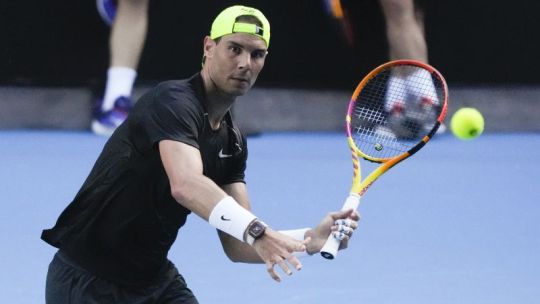
CNN — Defending champion Rafael Nadal will face English youngster Jack Draper in the opening round of the Australian Open in a bid to retain his 2022 crown and extend his grand slam tally. World No. 1 Carlos Alcaraz may be missing the tournament through injury, but with the return of Novak Djokovic to the competition, Nadal will be hard pushed to defend his title. Thursday’s draw was not kind to the 22-time major winner: if he defeats the world No. 40 Draper, he potentially faces current Next Gen ATP Finals champion Brandon Nakashima. Potentially awaiting the Spaniard later would be a quarterfinal against Daniil Medvedev, who was Nadal’s opponent in last year’s epic five-set final. Medvedev will be looking to make it a third consecutive finals appearance after losing to Djokovic in 2021 and to Nadal in 2022. A rematch of the 2021 final is on the cards, with Djokovic in the opposite half from Nadal and Medvedev. The nine-time Australian Open champion faces another Spaniard, Roberto Carballes Baena, in the opening round and is on track to face home favorite Nick Kyrgios in the last eight. The tournament comes 12 months after Djokovic was deported from Australia on the eve of the 2022 edition after former immigration minister Alex Hawke found the tennis star posed a risk to public health and order because, as a celebrity sportsman who had previously expressed opposition to people being compelled to get the Covid-19 vaccine, he could be seen as an “icon” for anti-vaxxers. The minister’s decision to deport the former world No. 1 meant he was initially banned from reentry for three years. Nineteenth-seeded Kyrgios is part of a thrilling section of the draw which includes Holger Rune, Dan Evans and Andrey Rublev. Russian Rublev comes into the Australian Open as the fifth seed, but on Wednesday suffered a shock defeat to world No. 110 Thanasi Kokkinakis in the Adelaide 2. Rublev faces a blockbuster opening round match against former world No. 3 and 2020 Australian Open finalist Dominic Thiem. Andy Murray features in the other pick of the round as he faces 13th-seeded Matteo Berrettini. The Italian beat the three-time grand slam winner in four sets at the 2022 US Open and has beaten the Scotsman three out of their four ATP meetings.
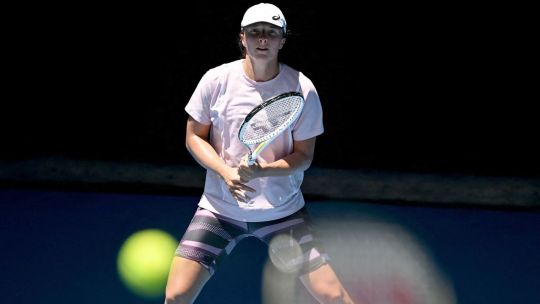
Following reigning champion Ashleigh Barty’s retirement from tennis last year, Iga Światek has dominated the sport and comes into the tournament as the top seed. The Pole opens against German Jule Niemeier but faces a tasty potential quarterfinal clash with American hot prospect Coco Gauff. The 18-year-old superstar comes into the tournament in fine form, having won the ASB Classic without dropping a set and is looking to build on her excellent 2022 which saw her reach the Roland Garros final where she was beaten by Światek. Ahead of any quarterfinal clash with the favorite though, Gauff faces a second round match against 2021 US Open champion Emma Raducanu who is in a race against time to recover from an ankle injury. In the other half of the draw, second seed Ons Jabeur starts her 2023 trying to go one better than last year and win a grand slam. The Tunisian made both the Wimbledon and US Open finals but fell at the final hurdle in her pursuit to become the first Arab and North African woman to win a grand slam. After missing the 2022 Open, Jabeur opens her 2023 account against Tamara Zidanšek and could face Aryna Sabalenka who is coming off the back of winning at Adelaide 1, her 11th career title and first in 19 months. Elsewhere, American Jessica Pegula has been drawn in the same part of the draw as Maria Sakkari. Pegula recently led Team USA to victory in the inaugural United Cup, which featured a brilliant straight-set win over Światek. Having reached back-to-back quarterfinals in Melbourne and at the top of her game, she will be looking to set up a thrilling semifinal with her United Cup opponent. Source link Read the full article
0 notes
Text
🎥 ATP Challenger Livestream (via website)
Meanwhile, in Santa Fe...
First seed Mariano Navone advanced to his second consecutive Challenger final this year after winning the title in Poznan Challenger a week before the Wimbledon qualifying rounds. His aggression would be pitted against qualifier and former junior World No. 1 Adolfo Daniel Vallejo, who dug deep to defeat third seed Roman Andres Burruchaga in three sets.
However, after two consecutive holds, there came the two consecutive breaks, one of which came out of Dani's erratic service game (and rushed follow ups). After Navone held his service game 3-2, he came up with another break after Dani's forehand error even if the latter tried to save it with a forehand winner.
At the end of the day, while consistent service games still become a question for Dani, Navone kept finding his grip by turning his defense to offense. This paid off with his forehand winner capitalizing on the set point to take the first set 6-2, setting a statement start to signify his experience.
#atp world tour#atp tour#atp challenger#atp challenger tour#tennis updates#set point#santa fe challenger#aat challenger santa fe#mariano navone#adolfo daniel vallejo#WatchChallengersFolks#ChallengerMatters
0 notes
Text
A rivalry is more than head to heads or titles won. Here's a thread of why the Federer-Nadal rivalry (2004-2022) is considered one of the greatests and most unique in sports history:

Roger Federer and Rafael Nadal are mirror opponents. A once in a century jackpot with two style of play at the opposite ends of the sports' techniques. In terms of athlete's posture, they are eerily of the exact same height and weight, yet Federer is a right-handed player with a one-handed backhand and Nadal is a left-handed player with a two-handed backhand. Federer portrayed the elegant, fast-paced serve and volley style of the past decade whereas Nadal introduced innovative heavy groundstrokes, topspin, and defensive baseline plays. They encapsulated the progress of the sports' development and their matches popularised tennis to unprecedented heights.
Roger Federer and Rafael Nadal are the respective best at their dominant surfaces. They both stil hold world records for most Grand Slam titles on grass (Federer with 8 Wimbledons) and on clay (Nadal with 14 French Opens), respectively dubbed King of Grass and King of Clay. From 2006 to 2008, they played every single Wimbledon and French Open finals against each other.


Roger Federer was the undisputed current world number one since 2004. He admitted he almost lost his passion for the game due to lack of competition until Nadal became the first to beat him in a grand slam final. They became the only pair in history to share the top two year end rankings for 6 years, from 2005 to 2010 and 2017. In their own words, they were each other's biggest motivations to achieve greatness.
Roger Federer and Rafael Nadal were the first to dominate the sports consistently for over a decade, ending the era of one or two odd times Grand Slam winners. Together they won consecutive majors from 2005 to 2007, 2008 to 2009, and 2017 to 2018. Their dominance kickstarted what was dubbed the 'golden era of tennis'.
As tournament seedings are based on rankings, their 40 matches were tournament quarters, semis, and finals, with the all time record of 9 Grand Slam finals. They were each other's partners in the worst and best moments of their careers.
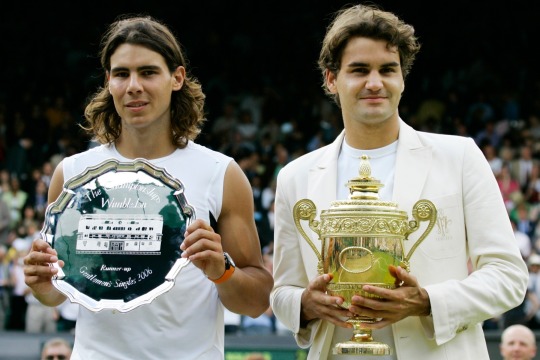

They played what is considered by most tennis analysts as the greatest tennis match in history: The Wimbledon final of 2008 for 4 hours and 48 minutes.
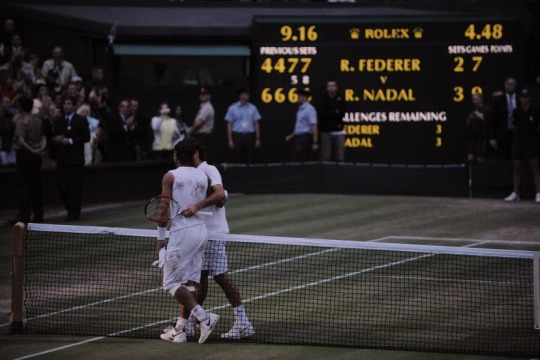
They were leaders of the game from the background, being president and vice president of the players' council for more than 10 years with both only agreeing to join if the other's participating.
They have played countless charity matches to support each other's foundations. In 2020 they broke the world record together, with their exhibition in Africa attracting the highest ever attendance in a tennis match.
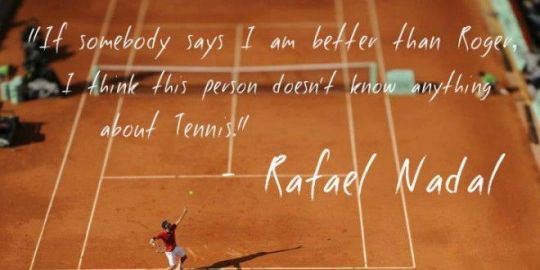
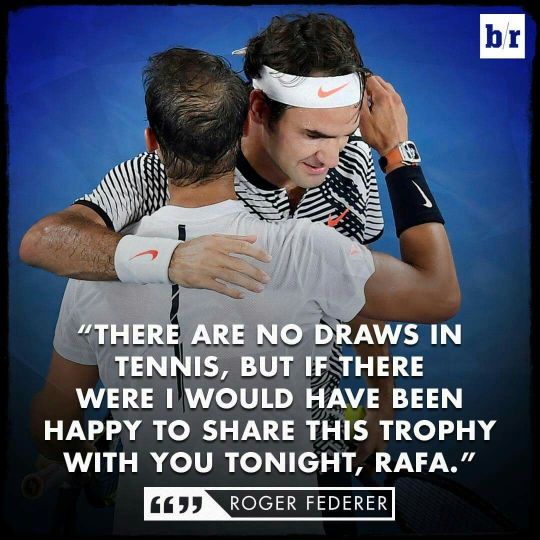
Known for their sportmanships, Nadal has openly expressed that he cried of happiness when Federer won his first ever French Open (Nadal's best tournament), whilst Federer expressed his wish to have a draw match and shared his 2017 Australian Open with Nadal.
Roger Federer and Rafael Nadal are two of the most successful, consistent, and longstanding tennis players of all time, playing more than 25 years of professional tennis with a record of 42 Grand Slams between them. Many have not known the sport without them, they are representative of a generation.
Roger Federer and Rafael Nadal remain close friends after almost 20 years of facing each other on court, having stated their friendship as the proudest milestone of their rivalry. As per his personal wish, Federer will retire playing doubles alongside Nadal in his last ever competitive tennis match.
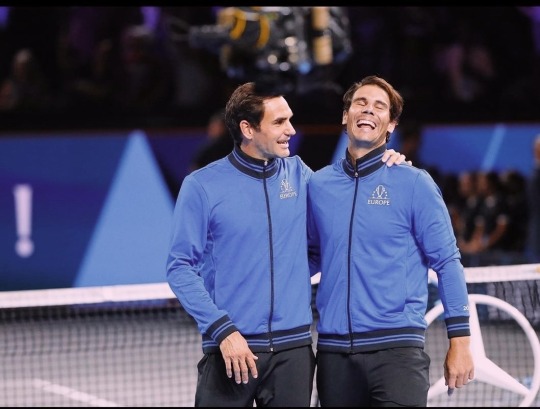
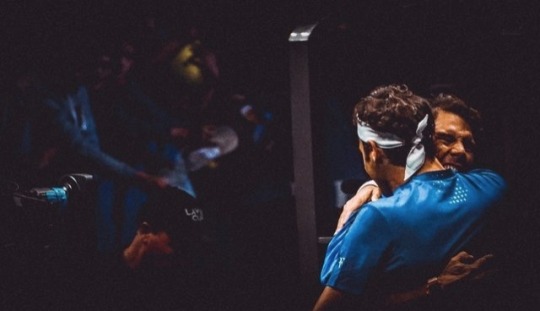
#i made the complete fedal saga guide#somebody has to do it right#this is why i call bullshit when ppl diminish their rivalry#it's a once in a lifetime occurrence#the best of the best in sports#fedal#rivalry#tennis#tennis rpf#roger federer#rafael nadal#sports#laver cup#wimbledon#french open
2K notes
·
View notes
Text


As they’ve started to become relevant in a few verses and threads, I wanted to write a little bit about some of Sonia’s extended family. Thus, here is some information about His Royal Highness Prince Arthur, Duke of Neuchatel (King Alexandre’s brother and only sibling, and Sonia’s uncle) and his family.
Note: Each member of this family is referred to as “His/Her Royal Highness” or “Your Highness,” despite Arthur and Olivia being the Duke and Duchess of Neuchatel. Because they are the sole Royal Duke and Duchess (with their titles granted to them upon marriage by the former King), they are addressed as Royal Highnesses as opposed to “Your Grace,” which is how other Dukes and Duchesses within Novoselic would be spoken of and to, if a servant or commoner is addressing them (at parties, or among those in the aristocracy, they are referred to as ‘Duke’ or ‘Duchess.’ No, it makes little sense and yes, it’s a lot to learn if your muse ends up working for/with Sonia in the Royal Family or your muse plans to marry her).
Everything is under the cut, as it’s pretty long!
His Royal Highness, the Duke of Neuchatel - Also known as Arthur, Duke of Neuchatel or informally as Arthur Nevermind (his last name, like his brother King Alexandre and his niece Princess Sonia, comes from their Royal House), he is King Alexandre’s only sibling. Born two years after his brother, Arthur proved himself to be charming and charismatic at a young age. Where Alexandre was thoughtful, introspective, and considerate, Arthur was bold and captivating. He loves a healthy competition no matter where it’s found, but he still grumbles that his brother still bests him in chess. His hobbies included shooting, skiing, and, to his mother’s dismay, gambling.
Despite being ‘the spare,’ Arthur relishes in being in charge, delivering orders and having his plans executed perfectly. It made him an ideal football captain in school as well as a member of the In Utero Student Council during his final two years of high school (he chose which events he wished to engage with. They were few and far-between). He consistently received the fastest training times throughout his military training, from obstacle courses to rope climbs to assembling firearms to driving tanks. His eagerness to guide others to victory made him an asset in the Novoselic Royal Army, where he completed his obligatory two years. He married Lady Olivia, daughter of the Duke of Vaud, two years after the Royal Wedding of-then Prince Alexandre, heir to the throne, and Lady Valentina, daughter of the Duke of Ticino.
Now, he is a full-time working royal for the Novoselic Royal Family with charitable interests in war veterans and science/technology. He’s an avid fan of the national football team, luxury fashion, wine, and his collection of rare watches and sportscars. He attends every Monaco Grand Prix and keeps a yacht on the French Riviera (which, on occasion, he’ll invite his wife along. This is not a frequent occurrence).
Before Sonia comes of age and graduates university, he is the one fulfilling many of King Alexandre’s international obligations, so he is often away from home. He prefers to travel in style (or rather, he prefers to have his entire life to be lived ‘in style.’).
Her Royal Highness, the Duchess of Neuchatel - Also known as Olivia, Duchess of Neuchatel or informally as Olivia Nevermind, is the wife of the Duke of Neuchatel and Sonia’s aunt. A bit shorter and fuller in the bust than her sister-in-law Queen Valentina, Olivia could be best described as ‘meek and mousy.’ While the King and Duke have golden hair and blue eyes, and the Queen with her platinum hair and green eyes, Olivia still retains the expected (if not requisite) blonde hair of the Royal Family, though hers is a mix of dirty and ash blonde. She has round brown eyes that can make her look permanently surprised if she’s not in control of her emotions.
Olivia is a gentle, soft-spoken woman whom, since birth, has been raised to take her place in Novoselic’s aristocracy. As a child, she loved embroidery, piano, and ballet, but was forced to give up the sport after her teachers insisted she was ‘too chubby’ to continue. From then on, she took up tennis and gardening as hobbies, with the latter carrying on well into her adult life. After marrying Prince Arthur and becoming the Duchess of Neuchatel, Olivia’s interests are, first and foremost, their two children and raising them to be the future Duke of Neuchatel and members of the Novoselic aristocracy.
She spends far more time at home than her husband, though she participates in every official engagement and function the Royal Family asks of her. She is a popular choice to be featured in documentaries and interviews, such as recorded tours around various Royal estates. Her philanthropic efforts are focused mainly around agriculture, animal conservation, horticulture, and children’s charities, and when she becomes of age, Princess Sonia and her aunt often share the duties for animal conservatory and children’s charity efforts.
While she does eat meat, she eats very little of it and tends to choose more fish and plant-based meals. She supports organic farming and hydroponics, and is the host of the annual Novosonian flower show. When she is able to go and invited, she loves to attend Wimbledon.
His Royal Highness, Prince Liam of Neuchatel - Also known as Liam, Prince of Neuchatel or Liam Nevermind, he is Sonia’s eldest cousin on her father’s side and four years younger than she is. A bit taller than his cousin and far more muscular (if not stocky), Liam is brash, loud, and generally unafraid to speak his mind in most matters. If there’s quips being slung in the Royal Family, he’s one of three possible suspects (the others are Queen Valentina and Prince Arthur).
Liam likes to be active and to have a good time, or a good laugh. During Princess Sonia’s first year attending the annual Masquerade Ball, he and some school friends from In Utero Primary School let loose a flock of makango into the ballroom, causing a great uproar when the animals took a dip in the champagne and chocolate fountains and scurried up skirts and trouser legs. Since then, Queen Valentina tends to frown whenever he’s discussed.
He’s not the biggest fan of school, though he has some talent for mathematics and statistics. Languages, literature, and history tend to put him to sleep. What he does like is physical fitness and sports, and won’t hesitate to try most athletics (ballroom dancing, and most types of dancing, are exempt. He hates these). He is primarily a polo and rugby player, but he enjoys football as well and likes to watch boxing and racing. Like his father, he enjoys being part of a sports team, though not necessarily leading it.
Upon graduation, he elects to attend university (or rather, his father tells him he’ll be going) and fulfill his obligatory military service during the school holidays (mostly so he doesn’t become mixed up in his usual partying crowd). While he wanted to be properly deployed, most of his military responsibilities involve defense, particularly at the Novoselic border. He’s frustrated by this and finds it difficult to focus, so during his holidays he’s often found in Spain or Greece, wherever the it-crowd has designated the coolest spot to see and be seen. And like his father, he quite likes luxury goods, expensive liquor, and sports cars. He’s also known to be quite handsome, with his mother’s ash blonde hair and his father’s blue eyes (otherwise known as the ‘Nevermind Blue.’ Sonia’s father, uncle, and Sonia herself all have them, as well as Liam).
Generally, if anyone’s going to appear in the tabloids, it’s usually Liam, and the Royal Family’s PR team has quite a job making sure anything incriminating never sees the light of day (or the light of a screen). His parents wish he’d settle down and actually have a real, meaningful relationship (that looks good in the eyes of the press and the people), but there’s no one special in his life. His charitable interests involve fitness and sports organizations, and he’s present at as many matches as he can. He loves when he’s sent to the Olympic Games to represent his country in the audience and in interviews.
His Royal Highness, Prince Samuel of Neuchatel - Also known as Samuel, Prince of Neuchatel or Samuel Nevermind, is the brother of Liam and Sonia’s cousin. He is two years younger than his brother and six years younger than Sonia. Where Liam is muscular, Samuel is not: however, he’s a good four inches taller than his brother, with long, golden hair (which he usually keeps tied back) and brown eyes (his mother’s). Samuel was one of the earliest targets of Liam’s jokes and jabs, and therefore he’s a bit quieter and considerate when it comes to his comments. Thoughtful and polite, he’s the ‘spare’ of the family and his parents worried he would grow up with a very thin skin. He didn’t take to athletics or military training nearly as easily as his brother Liam (though he took to video games: they bond over Mario Kart and Smash. It was a harrowing moment in Liam’s life the first time Samuel beat him at both).
Samuel is also an excellent student: history and art are his favorite subjects, though he gets exemplary grades in everything at In Utero. His hobbies and passions include visual art (he likes to sketch and paint) and playing the violin, and during the summer months he enjoys fishing. He’s very well-read and enjoys attending theatrical and musical productions as part of the Royal Family. Several of his drawings have been framed by his mother or King Alexandre and displayed in various Royal homes. He’d love to have something hung (besides a portrait of himself) in the National Gallery one day.
Upon graduation, he both chooses to attend University (seriously, he couldn’t get there fast enough) and to serve in the armed forces by joining the Novoselic Royal Air Force. Thus, he learned to both drive a tank and fly a plane before he could drive a car. Samuel loves flying for both work and fun, deeming the air to be the only place his family can’t chide or tease him. After his obligatory service, the Royal Family keeps a small, private plane for his singular use.
As he will not inherit the Dukedom (that will go to Liam), Samuel is both career-minded and a full-time working Royal. His charity work and proposed policies revolve around the arts, from new museums to theaters and productions to educational and grant opportunities. He is always working to add more cultural exhibits to every city and town in Novoselic.
It is often said by the press and public alike that Samuel acts more like they’d expect from the future Duke than Liam, a comment that never fails to upset the entire family.
#more-than-a-princess headcanons#(I have so. many. drafts. to write right now)#(But before I got to a few of them I thought this was necessary)#(Their historical AUs are altered depending on available technology of course)
6 notes
·
View notes
Text
Roland Garros Men's Final: Will It Be Alcaraz's Third or Zverev's First?

The stage is set for an electrifying men's final at Roland Garros, where a new champion will be crowned. The contest pits the tenacious Carlos Alcaraz against the formidable Alexander Zverev. Will Alcaraz secure his third Grand Slam title, or will Zverev finally achieve his maiden Grand Slam victory?
Alexander Zverev's Red-Hot Streak
Zverev enters the final riding a wave of momentum, having recently triumphed at the Rome Masters. His path to the final has been marked by impressive victories over top players such as Rafael Nadal and Casper Ruud. Despite these opponents not being at their peak, Zverev’s wins are a testament to his current form and resilience. Notably, Zverev survived two grueling five-set matches against Tallon Griekspoor and Holger Rune. Against Griekspoor, Zverev was down two breaks in the fifth set but showcased remarkable grit and determination to clinch the victory. Zverev's potent combination of a big first serve and relentless consistency in rallies makes him a formidable opponent on any surface.
Carlos Alcaraz: Overcoming Nerves and the Competition
On the other hand, Carlos Alcaraz has had a more tumultuous journey. His recent performance in the Roland Garros semifinal was shaky, characterized by an unusually high number of unforced errors. In his match against Jannik Sinner, Alcaraz committed 35 unforced errors and managed a first serve percentage of only 58%, leading to a nail-biting encounter that showcased more nerves than finesse.
To put this in perspective, while his average unforced errors in shorter best-of-three matches is around 23, the increase during the longer best-of-five sets highlights the pressure and intensity of the semifinals. Despite these challenges, Alcaraz remains the favorite to win the title. A victory here would mark his third Grand Slam on a different surface, putting him just one Slam away from achieving a career Grand Slam. Moreover, winning Roland Garros would bring Alcaraz within 1,000 points of Jannik Sinner in the ATP rankings, a crucial factor as he defends his Wimbledon title points while Sinner only defends semifinal points. This is key for Alcaraz's aspirations to end the year as World No. 1.
Head-to-Head Record
Overall Record: Alcaraz and Zverev have faced each other 5 times, with Zverev leading the head-to-head 3-2.
Clay Court Record: On clay, they have met 3 times, with Alcaraz leading 2-1.
Their encounters on clay have been particularly telling, showcasing the strengths and weaknesses of both players on this surface. Alcaraz's superior clay court record against Zverev could be a deciding factor in the final.
Key Stats and Comparisons on Clay
Carlos Alcaraz:
Win rate on clay in 2023: 84%
Average first serve points won: 72%
Break points saved: 68%
Alexander Zverev:
Win rate on clay in 2023: 78%
Average first serve points won: 74%
Break points saved: 65%
Alcaraz’s proficiency on clay is slightly higher, underscoring his tactical adeptness and comfort on the surface.
Strategic Keys for Victory
Alexander Zverev:
Consistent Rallies: Zverev’s ability to outlast opponents in long rallies, reducing unforced errors, will be crucial. His first serve will need to be on point to win easy points and put Alcaraz on the defensive.
Aggressive Return Game: Capitalizing on Alcaraz's second serve with deep, aggressive returns to force errors and seize control of points.
Carlos Alcaraz:
Topspin Forehand: Utilizing his heavy, high topspin forehand to push Zverev back and create opportunities to attack. This strategy can neutralize Zverev’s aggression and allow Alcaraz to dictate the pace of the match.
Variety and Drop Shots: Mixing up play with drop shots to exploit Zverev’s movement and pull him out of position. Alcaraz’s ability to change the rhythm and pace of rallies can disrupt Zverev’s game plan.
Mental Fortitude: Maintaining composure and minimizing unforced errors will be key for Alcaraz. His previous Grand Slam experience gives him an edge in handling the pressure of the final.
Finally....
While Zverev’s current form is undeniably impressive, Alcaraz’s overall proficiency on clay and his experience in Grand Slam finals make him the favorite. A victory here not only cements Alcaraz’s status as a clay court maestro but also brings him one step closer to a career Grand Slam and significantly impacts the ATP rankings. However, this match promises to be a thrilling encounter with both players having clear paths to victory. The player who can best execute their strategy and handle the high-stakes atmosphere will emerge as the new champion of Roland Garros.
The tennis world waits with bated breath to see whether it will be Alcaraz lifting his third Grand Slam trophy or Zverev celebrating his maiden triumph. Stay tuned for what promises to be an unforgettable final.
#RolandGarros#FrenchOpen#TennisFinal#Alcaraz#Zverev#GrandSlam#ClayCourt#TennisChampion#ATP#TennisMatch#Paris#TennisPredictions#TennisAnalysis#SportsBlog#YearEndNo1#CareerGrandSlam
1 note
·
View note
Note
hi!!! what are your us open expectations ? ik it’s difficult without a draw but
1) your ideal finals match-up (narrrative wise!)
2) who do you want to make a good run
3) who do you see could be a dark horse ala ben last year
4) who’s winning it all and what’s the match end score
wta:
I'd love to see coco vs iga with coco winning. to pull off a slam title defense against the world #1 who has also been her hardest rival would be incredible and I would go insane
jess, and by good run, I mean semis. please, what does she have to do to get to a slam semi. she's had such an amazing comeback from injury and her hardcourt season has been great so far, I think she really deserves it
I think diana shnaider is going to have a deep run. she's been very quietly making her way up the rankings and she's had some good wins lately. she's very consistent and with the usual us open chaos, I think that consistency will do her good
iga's probably gonna win it, I'll go with like 6-4 6-2
atp:
I'm gonna go with jannik vs casper. just based on vibes. I don't want a sincaraz final because their next grand slam match has to be an ao final to fit the narratives, it's all part of the grand plan
ok this is kinda gonna be the same reasoning as jess: taylor. wimbledon fucking hurt and I need him to make a slam semi so bad
ben again? no, I'll go with jiri, he had some amazing wins coming right off of injury and almost got to the semis in cincy. I think having time to train at the facility will help him and if he gets drawn in daniil's section, he's locked in
this one feels harder to predict, but I'll say jannik in 7-6 6-4 3-6 7-5
7 notes
·
View notes